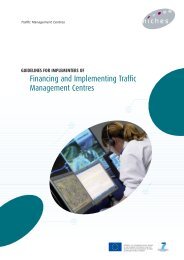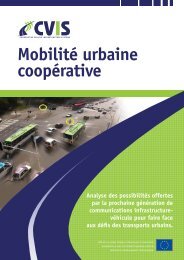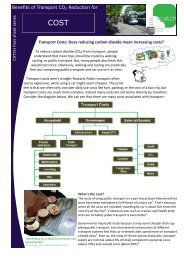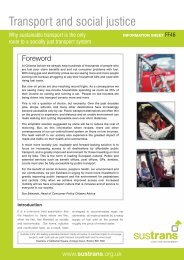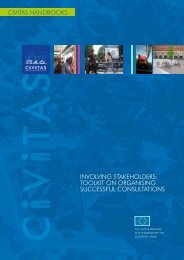EU funds for roads - CEDR
EU funds for roads - CEDR
EU funds for roads - CEDR
Create successful ePaper yourself
Turn your PDF publications into a flip-book with our unique Google optimized e-Paper software.
Page 63 / 80<br />
ANNEX 4:<br />
Fact-sheet <strong>for</strong> the loan guarantee instrument <strong>for</strong> trans-<br />
European transport network projects<br />
What is the LGTT?<br />
LGTT is the acronym <strong>for</strong> Loan Guarantee Instrument <strong>for</strong> Trans-European Transport Network<br />
Projects, an innovative financial instrument set up and developed jointly by the European<br />
Commission and the European Investment Bank (EIB) that aims to facilitate a larger<br />
participation of the private sector involvement in the financing of Trans-European Transport<br />
Network infrastructure (‘TEN-T’).<br />
What are the objectives of the LGTT?<br />
This new instrument facilitates private sector involvement in core European transport<br />
infrastructure, which often faces difficulties in attracting private-sector funding due to the<br />
relatively high levels of revenue risk in a project’s early operating stages. The LGTT, which is<br />
part of the <strong>EU</strong>’s TEN-T programme and the EIB’s Action <strong>for</strong> Growth initiative, partially covers<br />
these risks and consequently significantly improves the financial viability of a project. The LGTT<br />
is financed with a capital contribution of €1 billion (€500 million each from the Commission and<br />
the EIB), which is intended to support up to €20 billion of senior loans. The LGTT aims to<br />
facilitate investment in TEN-T projects by significantly improving the ability of the borrower to<br />
service senior debt during the initial operating period or ‘ramp-up’ phase of the overall project<br />
and of its initial traffic revenue. Its design substantially enhances the credit quality of the senior<br />
credit facilities, thereby encouraging a reduction of risk margins applied to senior loans to the<br />
project. These savings should surpass the cost to the borrower of the guarantee, resulting in a<br />
financial value-added <strong>for</strong> the project.<br />
Which transportation projects can benefit from the LGTT?<br />
Projects or part of a project of common interest in the field of transport in the framework of<br />
Decision No 1692/96/EC (the ‘TEN-T Project’) compliant with Community laws and <strong>for</strong> which<br />
financial viability is based in whole or in part, on revenues, tolls or other user-charges based<br />
income.<br />
How much financing can the LGTT provide?<br />
The stand-by liquidity facility guaranteed by the LGTT should not normally exceed 10% of the<br />
total amount of the senior debt (up to 20% in exceptional cases e.g. high traffic volatility during<br />
the ramp-up period with strong indication of stabilised traffic and acceptable debt service<br />
capacity post ramp-up). The amount of the guarantee is subject to a maximum ceiling of €200<br />
million per project pursuant to the EIB Structured Finance Facility rules (‘SFF’). The SFF is the<br />
EIB’s main facility <strong>for</strong> increased risk taking, established in order to support projects of European<br />
importance including large-scale infrastructure schemes.<br />
What risks does the EIB take under the LGTT scheme?<br />
Under the LGTT, the EIB will accept exposure to higher financial risks than under its normal<br />
lending activities. In effect, if the EIB guarantee is called upon by the stand-by liquidity facility<br />
(‘SBF’) providers at the end of the availability period, then the EIB would reimburse the SBF<br />
providers and become a subordinated lender to the project but ahead of any payment to the<br />
equity providers and related financings.<br />
<strong>EU</strong> <strong>funds</strong> <strong>for</strong> <strong>roads</strong>






